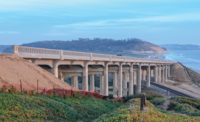As California Department of Transportation Construction Manager Douglas Coe tells it, the key to success on a very complicated seismic retrofit of the Antioch Toll Bridge is the mastering of the three B’s – birds, bearings and bracing.
Rebuilt in 1978 from the original 1926 edition, the steel-plate girder, 1.8-mi bridge spans the San Joaquin River from the East Bay city of Antioch in Contra Costa County to the Sherman Island wildlife refuge in Sacramento County along State Route 160. It has one lane in each direction with bicycle and pedestrian access and traffic numbers about 15,000 vehicles a day.
Though rebuilt with seismic criteria gained from the 1971 San Fernando earthquake, re-evaluations of the bridge’s structural integrity prompted the retrofit, according to Caltrans.
Caltrans awarded the $35-million contract to California Engineering Contractors, Pleasanton, in April 2010. Structural work was completed in mid-April and completion is scheduled for July 1.
According to CEC, the bridge features two structural elements – the Main Structure and the Slab Span Structure. The project involved reinforcing the girders, jacking of the bridge, replacing the existing TFE/Elastometric bearings with custom designed low-profile friction pendulum isolation bearings and installing steel cross bracing between columns to stiffen the superstructure cross frames on each of the 41 piers.
Caltrans says cross braces were tied into vertical steel columns up to 140 ft high, which were embedded in cast-in-place concrete along the vertical face of each tower.
The bridge was not closed during the retrofit work, according to David Tenorio, Caltrans’ senior bridge resident engineer, but one-way reversible traffic control was used when replacing some of the bearings.
Coe and Steve Banke, CEC project manager, concur that scheduling played a key role in getting the project done on time and on budget. Caltrans knew in advance that the bridge attracted five different types of birds that used the structure for nesting. These include the Barn Owl, House Finch, Cliff Swallow, Barn Swallow and Northern Mockingbird. CEC biologist Scott Sandkohl adds that other species used the bridge for roosting and caching as well.
Coe says the challenge was to find a way to prevent the birds from nesting on the bridge during the patterned nesting season between Feb. 1 and Sept. 30.
“With Barn Owls, for example, once they’ve nested you’ve lost six to 12 weeks of work before the eggs hatch,” says Coe.












Post a comment to this article
Report Abusive Comment